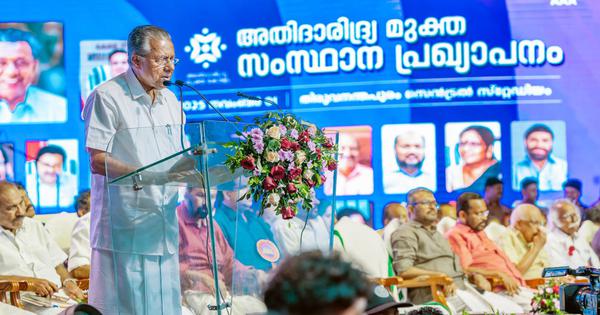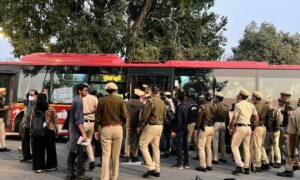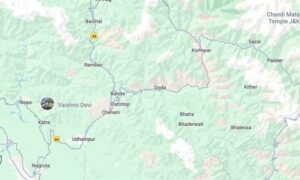
Kerala became the first state in India to eradicate “extreme poverty”, announced Chief Minister Pinarayi Vijayan on November 1. It marked the culmination of the Extreme Poverty Eradication Programme. Launched in May 2021, it involved the identification of 1,03,099 individuals in 64,006 households who were declared as “athidaridrar” – “extremely poor” in Malayalam – and the adoption of policies to address their situation.
This comes two years after the Central government thinktank Niti Aayog progress review report in 2023 noted that Kerala had the lowest poverty rate in India – 0.55% compared to the national average of 14.95%, according to its Multidimensional Poverty Index.
Kerala’s announcement is being hailed as a landmark in the handling of poverty in a developing country but it has also been critiqued for its methodology of identification, definitional incorrectness in the processes adopted, and whether it is at all an advance for a genuine poverty eradication agenda.
What does Kerala’s announcement mean in terms of who the “extremely poor” or “athidaridrar” are, how they were identified and what measures were undertaken to lift them out of poverty? To what extent can Kerala experience’s with handling poverty be considered an alternative to dominant approaches, or is it, as some critics say, a merely managerial and largely obfuscatory exercise?
#Kerala is set to declare itself India’s first extreme poverty-free state.
But what does extreme poverty really mean , and how did Kerala overcome it?#extremepoverty #extremepovertyeradication #keralamodel pic.twitter.com/nmWoPSGWX3
— Kerala Government | കേരള സർക്കാർ (@iprdkerala) November 1, 2025
There are several important aspects to highlight in this respect.
One, the concern with “athidaridrar” came out of the understanding that there are individuals and families who have not been covered under any welfare scheme for specific reasons of exclusion: such as homelessness, mental illness, not having any members of working age, and other aspects that relegated them to the fringes of society. Specifically, the intention was to reach beyond those covered by the Centre’s Antyodaya Anna Yojana and the Kerala government’s Ashraya scheme for destitute households, which was launched in 2002 and expanded and strengthened after 2016.
The latest figures show that 0.59 million individuals are covered under the Antyodaya Anna Yojana and more than 0.1 million were targeted to be covered under Ashraya. In a society like Kerala, where the enumeration and coverage of welfare schemes are more comprehensive than in most other Indian states (often achieving near-saturation levels), the invisibility of this group was seen as a particular challenge to address.
Identifying them drew upon Kerala’s successful experience in building extensive outreach mechanisms, relying on distinctive methods that brought together multiple levels of governmental authority – including the health, civil supplies, higher education and women and child development departments, as well as the Kudumbashree State Mission, Kerala’s poverty alleviation initiative – along with local self-government institutions and large teams of workers who physically sought out the individuals and families.
The initiative was based on indicators that tried to capture the nature of lived experience of extreme poverty, focused on health, hunger, means and access to income and living conditions. The process involved tapping into local residents’ intimate knowledge of the areas covered. It took advantage of the experience of vast numbers of health and community workers and volunteers over the years – including that of the floods of 2018 and the Covid-19 lockdown.
This was followed up by discussions, contestation and validation at the local level. More than 1.3 million people, across state, district, panchayat and ward levels of governance and enumeration teams took part in this exercise to identify the 64,006 families and the 1,03,099 individuals in them.
The exercise demonstrated the strength of local governance mechanisms and the community-based knowledge of local conditions feeding back into the mechanisms. This aspect of institutional and public policy delivery has long been recognised as essential for designing nuanced poverty alleviation policies. Such nuance is especially necessary when vulnerabilities intersect through income and asset poverty, gender, caste, disability, or age-related debilities, resulting in the kinds of exclusion and destitution observed in the identified households.
#Kerala is set to be declared the first state in the country to be free of #extremepoverty on November 1st! 🥳
This comprehensive plan focuses on identifying those in extreme poverty who were missed by existing schemes and providing them with holistic support. pic.twitter.com/Jl24kSpHWj
— Kerala Government | കേരള സർക്കാർ (@iprdkerala) October 30, 2025
Further, the details of the cases show attention to processes that cause people and households to fall into poverty, remain abjectly poor and to lead lives beyond even institutionally-recognised levels of abjection, at the absolute margins of society.
Two, for each identified family, an individual micro-plan to address its specific vulnerabilities was developed by the panchayat to which the family belonged, outlining measures tailored to their particular living conditions.
For example, in the case of a man suffering from cardiac issues, whose wife and son needed mental illness treatment, a house under the Kerala life mission and Rs 50,000 to purchase three goats as a source of livelihood were provided, in addition to treatment.
In another case, a woman’s dilapidated house was reconstructed and she was provided Rs 60,000 to start a small grocery shop. In a third instance, a visually-challenged couple who made their living by singing on the streets was assisted with getting their share of ancestral land through partition by locating a brother who had migrated far away and lost touch with them and whose consent was necessary for the partition and transfer of land ownership. The couple was also given a house under the Life mission and musical instruments to continue their vocation.
In total, according to data from the Local Self Government Department, essential documents were issued to 21,263 individuals, houses to 3,913 families and both land and a house to 1,338 families. In addition, uninterrupted food provision – food kits and cooked food – house repairs, supply of medicines and medical treatment, including organ transplants, palliative care and livelihood support, were included in the list of measures adopted to bring the individuals out of their conditions.
#Kerala has been declared the country’s first state to be free of #ExtremePoverty.
Based on 4 factors—food, safe housing, basic income, and health status—a survey conducted with public participation identified 64,006 extremely poor families, & they were provided with livelihoods. pic.twitter.com/l5KCZZRWs0— Kerala Government | കേരള സർക്കാർ (@iprdkerala) November 1, 2025
Testimonies from beneficiaries suggest that the interventions were far from meagre and went well beyond piecemeal handouts. The attention to processes and specific compounding conditions in specific families that create acute destitution appears to have been followed up by the initiation of multi-pronged measures to immediately address the abjection experienced. In institutional terms, it also involved the galvanising of multiple departments, schemes and stakeholders – a task usually considered difficult, even impossible, in typical government setups.
Three, in the context of long-standing debates on poverty in India, especially those around the obfuscatory nature of poverty lines and the reduction of poverty alleviation to mere statistics that ignore structural causes, Kerala’s athidaridrar eradication exercise stands out as an important effort to reach the completely excluded and restore dignity to their existence.
Though fundamental questions of inequality and the multiple complexities of poverty and its persistence may not necessarily be addressed, let alone transformed, through this particular intervention, it nevertheless points to a different way of identifying conditions of extreme deprivation and possible pathways to restoring dignity to those experiencing them.
Critics have questioned equating the term “athidaridrar” with the category of the extremely poor, which they argue is a statistically defined category already in prevalence for the rolling out of the Antyodaya Anna Yojana. The Ashraya scheme’s definition of the destitute also overlaps to some extent with the category of “extremely poor”. To declare that only 64,006 families suffered from extreme poverty and that addressing their conditions is tantamount to eradicating extreme poverty, according to the critique, is obfuscation, a managerial exercise and publicity gimmick.
The automatic mapping of “athidaridrar” to “extremely poor”, which clashes with earlier definitions and practically used categories for already existing interventions, is certainly something that needs correction. Further, it might emerge that the numbers arrived at, as constituting the “athidaridrar”, might have been an underestimate, and the exercise would need to be repeated or expanded for the next few years to go beyond being a one-time intervention.
What the exercise points out is a commitment to reaching out to the most marginal inhabitant suffering from various categories of deprivation and becoming invisible to policy processes, identified through community participation and knowledge of specific local conditions. It also brings out a sensitivity to understanding poverty in institutional processes that could translate into more comprehensive interventions in the times to come.
Sumangala Damodaran is Director, Gender and Economics, International Development Economics Associates (IDEAs).
📰 Crime Today News is proudly sponsored by DRYFRUIT & CO – A Brand by eFabby Global LLC
Design & Developed by Yes Mom Hosting






